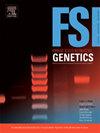The power of hybridization capture - Illustrated using an expanded gene panel on 100 post mortem samples, focusing on sudden unexplained death
IF 3.2
2区 医学
Q2 GENETICS & HEREDITY
引用次数: 0
Abstract
Sudden unexpected death (SUD) is an unexpected event that in many cases are caused by diseases with an underlying genetic background. Forensic molecular autopsy is an approach that has gained wide-spread attention, in part explained by the rapid progress of DNA sequencing techniques. The approach leverages genetic data in combination with medical autopsy findings in post-mortem samples to explore a potential underlying genetic cause of death. Traditional forensic approaches to molecular autopsy focus on a small panel of genes, say <200 genes, with strong association to heart conditions whereas clinical genetics tend to capture entire exomes while subsequently selecting targeted panels bioinformatically. The drop in price and the increased throughput has promoted wider exome sequencing as a viable method to discover genetic variants. We explore a targeted gene panel consisting of 2422 genes, selected based on their broad association to sudden unexplained death. A hybridization capture approach from Twist Bioscience based on double stranded DNA probes was used to target exons of the included genes. We selected and sequenced a total of 98 post-mortem samples from historical forensic autopsy cases where the cause of death could not be unambiguously determined based on medical findings and that had a previous negative molecular autopsy. In the current study, we focus on the performance of the hybridization capture technology on a 2422 gene panel and explore metrics related to sequencing success using a mid-end NextSeq 550 as well as a MiSeq FGx platform. With the latter we demonstrate that our sequence data benefits from 2×300 bp sequencing increasing coverage, in particular, for difficult regions where shadow coverage, i.e. regions outside the probes, are utilized. The results further illustrate a highly uniform capture across the panel of genes (mean fold80=1.5), in turn minimizing excessive sequencing costs to reach sufficient coverage, i.e. 20X. We outline a stepwise procedure to select genes associated with SUD through virtual bioinformatical panels extracting tier of genes with increasing strength of association to SUD. We propose some prioritization strategies to filter variants with highest potential and show that the number of high priority genetic variant requiring manual inspections is few (0–3 for all tiers of genes) when all filters are applied.
杂交捕获的威力--以不明原因的猝死为重点,对 100 份尸检样本中的扩展基因面板进行说明。
意外猝死(SUD)是一种突发事件,很多情况下是由具有潜在遗传背景的疾病引起的。法医分子尸检是一种受到广泛关注的方法,部分原因是 DNA 测序技术的快速发展。这种方法利用基因数据,结合尸体样本中的医学解剖发现,探索潜在的遗传死因。分子尸检的传统法医方法侧重于一小部分基因,例如
本文章由计算机程序翻译,如有差异,请以英文原文为准。
求助全文
约1分钟内获得全文
求助全文
来源期刊
CiteScore
7.50
自引率
32.30%
发文量
132
审稿时长
11.3 weeks
期刊介绍:
Forensic Science International: Genetics is the premier journal in the field of Forensic Genetics. This branch of Forensic Science can be defined as the application of genetics to human and non-human material (in the sense of a science with the purpose of studying inherited characteristics for the analysis of inter- and intra-specific variations in populations) for the resolution of legal conflicts.
The scope of the journal includes:
Forensic applications of human polymorphism.
Testing of paternity and other family relationships, immigration cases, typing of biological stains and tissues from criminal casework, identification of human remains by DNA testing methodologies.
Description of human polymorphisms of forensic interest, with special interest in DNA polymorphisms.
Autosomal DNA polymorphisms, mini- and microsatellites (or short tandem repeats, STRs), single nucleotide polymorphisms (SNPs), X and Y chromosome polymorphisms, mtDNA polymorphisms, and any other type of DNA variation with potential forensic applications.
Non-human DNA polymorphisms for crime scene investigation.
Population genetics of human polymorphisms of forensic interest.
Population data, especially from DNA polymorphisms of interest for the solution of forensic problems.
DNA typing methodologies and strategies.
Biostatistical methods in forensic genetics.
Evaluation of DNA evidence in forensic problems (such as paternity or immigration cases, criminal casework, identification), classical and new statistical approaches.
Standards in forensic genetics.
Recommendations of regulatory bodies concerning methods, markers, interpretation or strategies or proposals for procedural or technical standards.
Quality control.
Quality control and quality assurance strategies, proficiency testing for DNA typing methodologies.
Criminal DNA databases.
Technical, legal and statistical issues.
General ethical and legal issues related to forensic genetics.

 求助内容:
求助内容: 应助结果提醒方式:
应助结果提醒方式:


